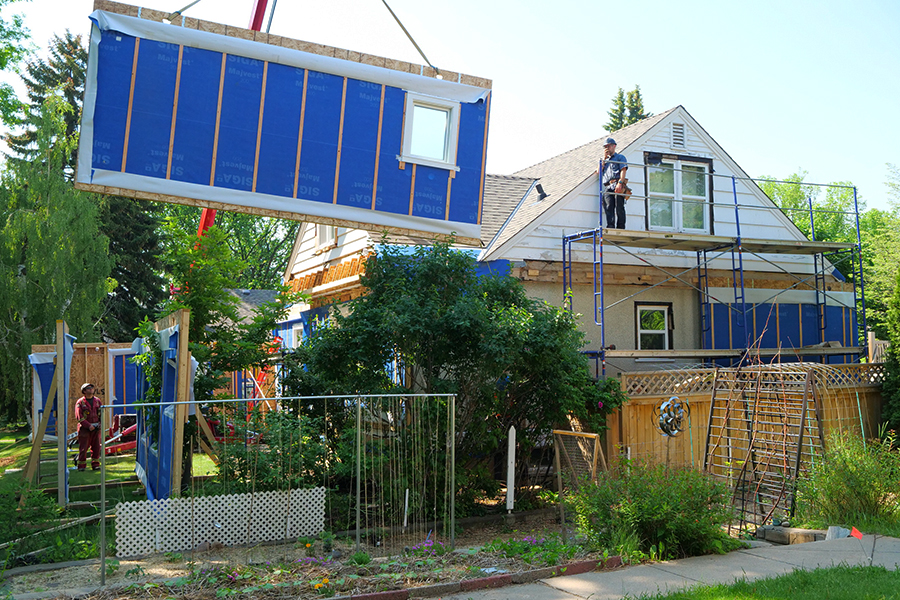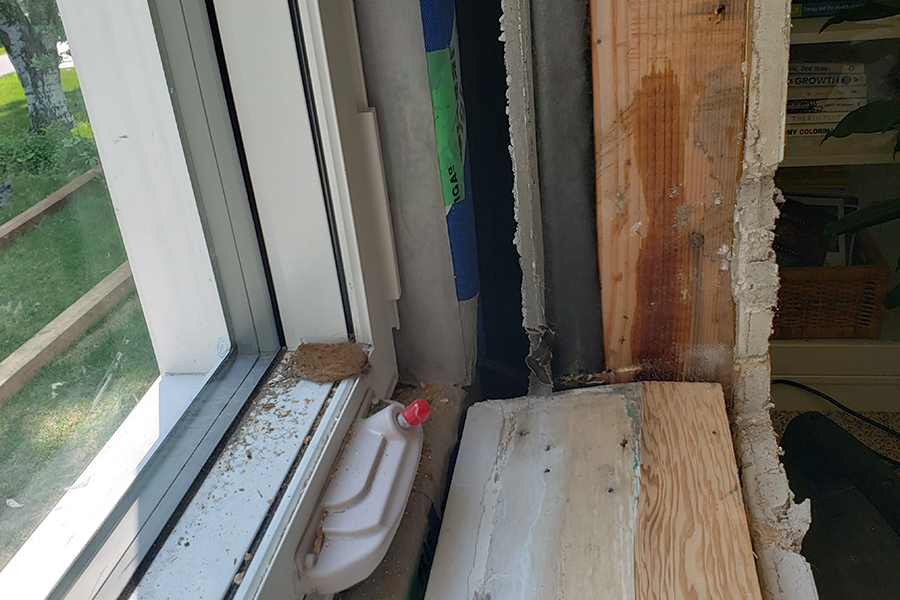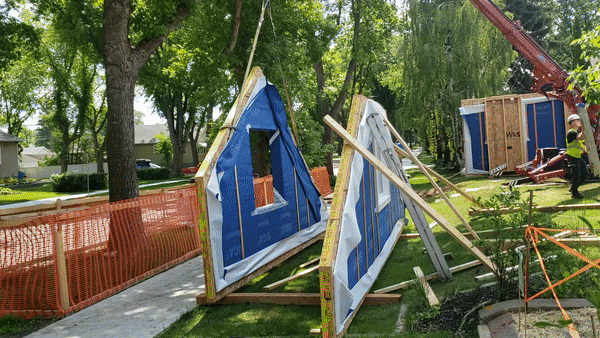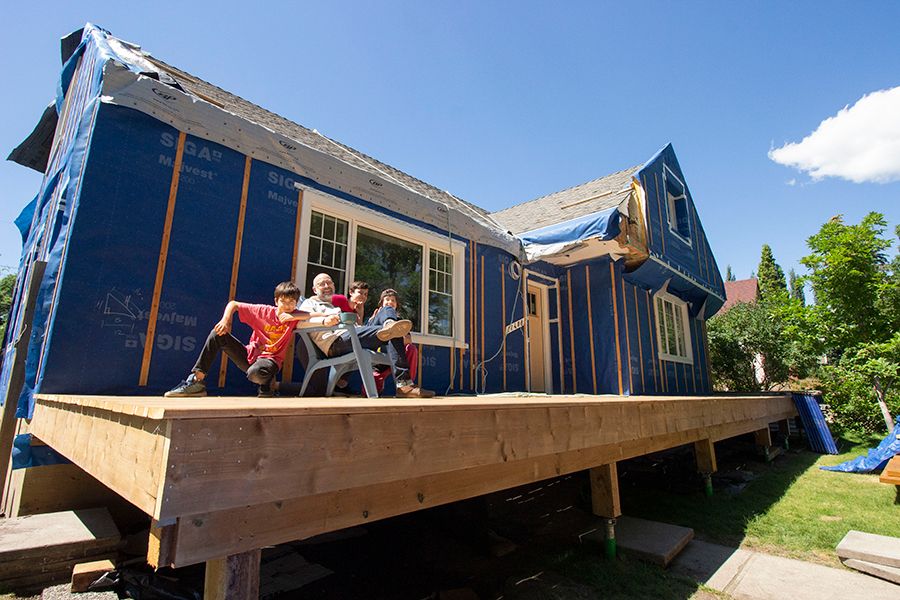Dr. Jim Sandercock helps bring the Dutch “energiesprong” concept to Edmonton
Dr. Jim Sandercock’s east Edmonton home was once typical for the area.
In fact, the chair of NAIT’s Alternative Energy Technology program described it as having been “nondescript” – a stucco-clad, post-World War II bungalow, compact but roomy enough thanks to living space in the attic. It’s surrounded mostly by other post-World War II bungalows that could be similarly described, on a quiet street shaded by the towering vases of elms common in the city.
But today it is far from being nondescript.
This summer, the mid-20th century home, which Sandercock shares with his wife and four kids, became unique not just in Edmonton but across the continent, when work began on a retrofit of the home based on a Dutch construction philosophy. Known as energiesprong, the approach strives for net-zero efficiency in a consciously low-waste, noninvasive way.
“We’re going to put a giant sleeping bag over the house, essentially,” said Sandercock at the time.
And, naturally, as a leading educator in the field of sustainability, he’d see that results of this renovation – a type previously unseen in North America on a single detached home – are documented so the work might play a role in helping Canada reach its target of achieving net-zero as a nation by 2050.
The quest for net-zero

Homes and buildings account for 18% of greenhouse gas emissions in Canada, according to the federal government. That includes fossil fuel use for heating, lighting, cooling and running appliances. Canada Green Building Council bumps that portion up to nearly 30% when considering construction for building from scratch, a carbon-intensive process.
“You can’t hit net zero if one of your sectors doesn’t hit net zero,” said Sandercock. Most of the buildings that will be standing in 2050, he points out, will have been built to conventional or outdated efficiency standards, making the housing sector a liability. “What are we going to do about that? You’re not going to bulldoze them all and rebuild.”
Sandercock’s project, handled by Butterwick, a leading Edmonton net-zero home design-build firm, represents a possible solution.
The “sleeping bag” analogy is not far from reality. Based on scans of Sandercock’s house to create a virtual 3D model, panels were built offsite, complete with triple-pane windows, and then brought to the home and attached to the exterior. To avoid introducing thermal bridges, or materials that join inner and outer walls and make pathways for heat loss, those panels connected to the existing walls only at the top and bottom. This “box,” as Sandercock described it, was then filled with blow-in insulation.
Notably, no living space was lost to the effort – though they did create window sills about nine inches deep. “We do not have a cat at this time but the opportunities are ripe for a cat,” Sandercock joked.

So are those for energy savings. The panels will improve wall insulation by a factor of five, from a rating of about R8, Sandercock estimated, to around R40. The roof, carefully extended around the dormers, was boosted to a value likely exceeding R50.
In all, the new envelope would be sufficient to decrease the hourly total air turnover in the house from four times – indicative of significant draftiness – to about once an hour.
Other changes will make electricity the only energy source for the home, which was already powered by solar (the size of the array was set to increase from 7.4 kilowatts to 15) but heated by natural gas. Sandercock gave up the furnace for a heat pump, which draws warmth from the exterior air in cooler months (or from the interior, for cooling in summer), and connected the hot water tank to a heat pump of its own.
Cutting the natural gas line proved a tough choice only in one respect. The family loved to cook on its open-flame stove.
“Of all the things, I think switching to induction was the hardest to grapple with,” said Sandercock.
A living laboratory

Even if the project was focused on the exterior and therefore not overly disruptive to daily family life, it was a significant undertaking, physically and financially (see sidebar below).
But, for Sandercock, the alternative – doing nothing – seemed harder to accept.
“My wife and I have four kids, a couple of nephews and nieces, and we were thinking, ‘What kind of world are we going to end up leaving them?’” Sandercock told me.
In an effort to find out, he’ll measure energy consumption in the home using a Sense monitoring system. The data will serve several purposes. Retrofit Canada, an organization dedicated to helping to meet Canada’s 2050 goal, will use it to help fine-tune energy modelling in the homebuilding industry. Alternative Energy Technology students will also study the home’s energy consumption, and test their own modelling efforts against those achieved by the pros. Sandercock will even allow them to hone their skills running blower tests on the home to see if they arrive at the expected results.
This living laboratory will soon be fully operational.
As of November 2022, the transformation is nearly complete, apart from the solar expansion. Once white-stuccoed and plain, Sandercock’s house is ready for a fresh facade of teal blue siding, along with a front deck that easily offsets any exterior square footage consumed by the extended walls. It’s a standout on the block, a 70-year-old compact bungalow made unique for helping to reach a goal for a better future.
If Sandercock gets his wish, it won’t be unique for long.
What did this cost and how might it be paid for?
 Alternative Energy Technology chair Jim Sandercock won’t reveal the cost of the deep retrofit recently applied to his house by Edmonton’s Butterwick homebuilder, but it’s safe to say it wasn’t cheap. But it is also safe to say, he adds, "that, as more homes are similarly transformed, the price will slide down the learning curve."
Alternative Energy Technology chair Jim Sandercock won’t reveal the cost of the deep retrofit recently applied to his house by Edmonton’s Butterwick homebuilder, but it’s safe to say it wasn’t cheap. But it is also safe to say, he adds, "that, as more homes are similarly transformed, the price will slide down the learning curve."
In the meantime, Sandercock points out, there is support. Work on his home was funded in part by the Smart Sustainable Resilient Infrastructure Association, which contributes to projects by construction companies looking to make low-carbon advancements.
Other avenues of support include HERA, Edmonton’s Home Energy Retrofit Accelerator, which provides rebates for upgrades, says Sandercock. The Canada Greener Homes Initiative offers similar grants on a national scale.
Low-to-no-interest loans are another option, says Sandercock. Alberta’s Clean Energy Improvement Program is administered by participating municipalities that collect on loans through a homeowner’s property taxes. The Canada Greener Homes Loan offers $5,000 to $40,000 interest free, to be repaid over a maximum of 10 years.